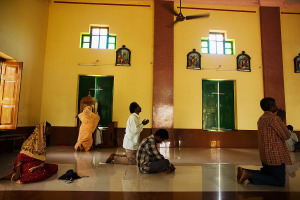Stained Glass Windows for Churches May Make Comeback With Younger Generations

Churches fitted with ornate stained glass windows may not become a thing of the archaic past just yet, noted one church construction company.
Although presently the stained glass industry has been experiencing a decline in business, research among younger Americans indicates that stained glass could experience a comeback.
Derek DeGroot, architect with the Aspen Group, a company that specializes in building churches, explained to The Christian Post on Monday the current trend.
"Although certain denominations still use stained glass traditionally, many mainline protestant denominations that we designed & built for have seen an apparent decline in the use of stained glass in the recent past," said DeGroot.
"However, there are new discussions that stained glass is seen more favorably by younger generations."
DeGroot cited recent research conducted by the Barna Group, which found that Millennials preferred more traditional looking sanctuaries instead of so-called trendy buildings.
"It seems the Hollywood depiction of the church has remained traditional (think cathedral), and the unchurched not familiar with the 'megachurch' of the '90s and 2000s sees an alarming disconnect with today's buildings and traditional church architecture," said DeGroot. "The ambiguous designs are confusing a new generation that is begging for more visual clarity with regards to the built environment and the faith of those inside."
Last August, surveys administered online to 843 young adults ages 18 to 29 by Barna and Cornerstone Knowledge Network, the market research organization created by church design firms Aspen Group and Cogun, found 67 percent chose the word "classic" to describe their ideal church. Only 33 percent preferred a trendy church as their ideal.
"It's tempting to oversimplify the relationship between Millennials and sacred space," says Dr. Clint Jenkin, vice president of research at Barna and the lead designer of the study, in a statement released last November.
"Most Millennials don't look for a church facility that caters to the whims of pop culture. They want a community that calls them to deeper meaning."
DeGroot's recent comments to CP come in response to an apparent decline in the number of churches using stained glass windows.
Timothy W. Martin of the Wall Street Journal wrote last month about how the stained glass industry was suffering from some "serious cracks."
"Declining church attendance is playing a role, as is the growth of nondenominational congregations … that pine for a more modern aesthetic," reported Martin. "Even churches that want stained glass are increasingly evaluating whether it fits in the budget."
A longtime mainstay of church design, stained glass windows have existed for several centuries, being first used during the Medieval timeperiod.
The ornate artwork served an educational purpose, illustrating scenes from the Bible for a mostly illiterate population.
"Stained glass has been a mainstay in churches for around 1,300 years. Most experts point to old French chapels and cathedrals, including Sainte-Chapelle and Notre Dame, as the finest examples of stained glass," noted Martin of WSJ. "They took hundreds of years to complete. Before specialized cutting wheels, artisans would individually chisel pieces with a hot iron and pliers."
Regarding the current trends, DeGroot was cautious about saying that Millennials' interest in more traditional sanctuaries may lead to a "resurgence" of stained glass windows, but noted that "new research has brought some interesting results."
"I believe they are indicating that large open glass windows are a good thing, but that there are some venues where traditional, ornate stained glass would be a great fit," said DeGroot to CP. "This may cause even contemporary churches to consider stained glass, especially in chapels or other venues that need something that speaks 'church.'"




























